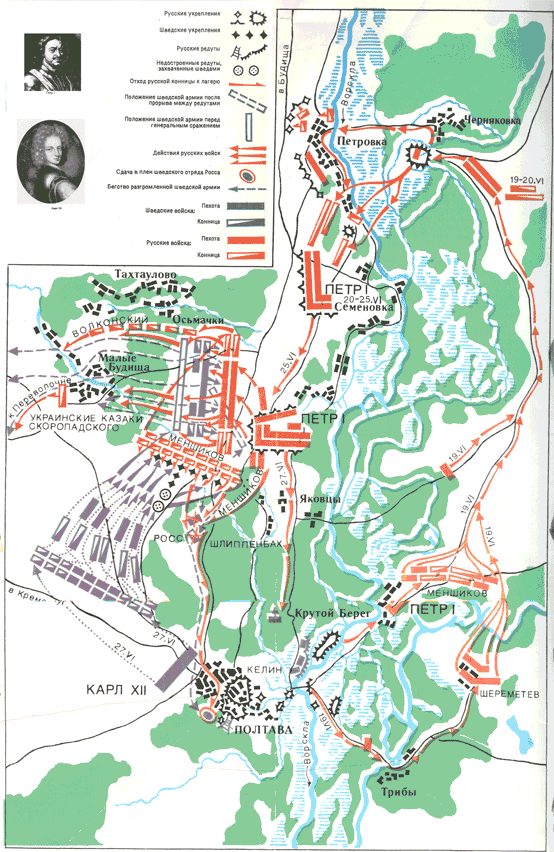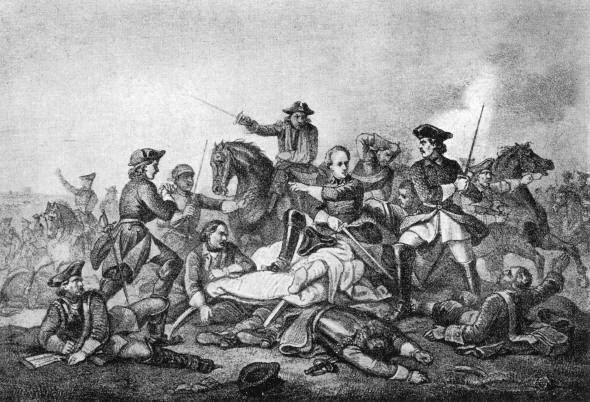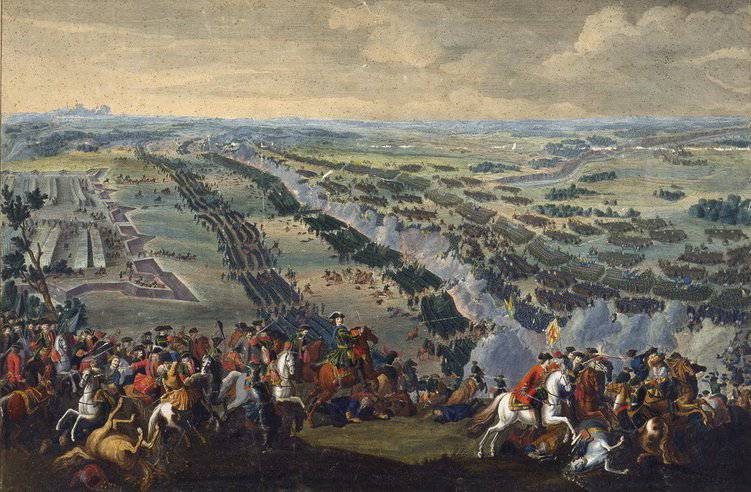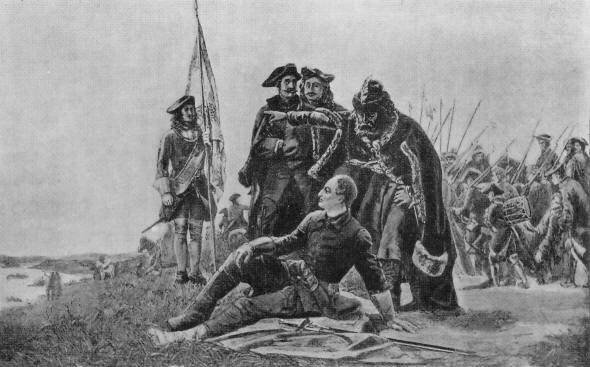Strategic turn in the Northern War - the Battle of Poltava
The hour has come, which must decide the fate of the Fatherland. You should not think that you are fighting for Peter, but for the state, Peter was given, for his family, for the Fatherland, for our Orthodox Faith and Church. You should also not be embarrassed by the glory of the enemy, as if invincible, to whom you have repeatedly proved your lies with your victories over him. Have in battle in your sight the righteousness and God who conquers against you. And about Peter, know that His life is not His way, if only Russia would live in bliss and glory for your well-being.
(From the appeal of Peter I to the troops on the eve of the Battle of Poltava)
After the failure of the storming of Poltava for the Swedish army, the situation was extremely unsuccessful. Ottoman Empire after a demonstration of Russian forces fleet She wasn’t going to help the Swedes; in the Polish-Lithuanian Commonwealth, Karl’s protege, Stanislav Leshchinsky, was tied hand and foot in the struggle with the Russian detachment of Goltz and hostile Polish detachments under the command of the hetman Sinyavsky. The attempt to attract the population of Ukraine to the war with the Russian Tsar failed, people were hostile to the interventionists. The Swedish army began to feel a shortage of food supplies, and there was not enough ammunition. People were tired, their morale was greatly undermined by the unsuccessful siege of Poltava. It was impossible to wait any longer, it was necessary to leave the Dnieper to Poland, or to give a decisive battle. The Swedish monarch considered that only a victory in a general battle over the Russians would be a sure way out of a difficult situation. The Swedish king decided to attack Russian positions at dawn on June 27.
The Russian army 25 June took a position near the village of Yakovtsy, the 26-st began to build a fortified position here. 29 was planning to attack the Swedes on June, but X-NUMX-th in the Russian camp arrived defector, who told the king that the 25-th Swedish army will go on the offensive. “To the beginner, God,” said Peter calmly, recognizing this news, and the Russian command began to make final preparations for the battle.
The fortified camp of the Russian army near the village of Yakovtsy, with its rear, adjoined the steep bank of the r. Vorskla. To the right of the camp stretched hollow, and on the left side was a forest that stretched to the Poltava Holy Cross Monastery. In front of the front there was a glade up to two versts wide, bordered on the north-west side by another forest. Between this forest and the monastery there was an open gap up to one mile wide. It was only this free space that the Swedish army could use to move from Poltava to the Russian camp. Peter decided to fight in the most favorable conditions and ordered to build in the passage between the forests six separate fortifications (redoubts), which were at a distance of a rifle shot from each other. These were quadrangular earthworks with moats and parapets. Four additional redoubts, which were built perpendicular to the line of the first six, should strengthen the forward position. As a result, the advancing Swedish army had to stumble upon redoubts, and then either storm them — wasting forces, time and money, or breaking through them, suffering heavy losses due to flank fire. After breaking through the redoubts, the Swedes ran across the main forces of the Russian army, which were located in a fortified camp. The idea to create redoubts on the battlefield belonged to Peter, it was a novelty in the military art of Europe.
On the day of the decisive battle, the Russian army consisted of an 61 battalion of infantry, a 23 dragoon regiment, several thousand Cossacks and 72 guns, only about 50 thousand people. It was a formidable force that went through a severe 9-year-old combat school. Many regiments participated in the sieges and storming of the Baltic fortresses, in various battles, including the Battle of Forest. During the war years, Russian commanders, the tsar's comrades-in-arms, also gained tremendous military experience: judicious and careful field marshal Boris Sheremetev; resolute and initiative, excellent cavalry general Alexander Menshikov; guard commander Mikhail Golitsyn; a participant in all the major battles of the Great Northern War, who was defeated at Golovchin, demoted to the soldiers, distinguished himself in the battle of Lesnaya and restored in the rank of general Anikita Repnin; an excellent engineer and gunner Jacob Bruce.
In the advanced redoubts there was a garrison of two battalions of the Belgorod regiment under the command of Brigadier Aigustov. Behind the fortifications was located the entire cavalry led by Menshikov. The main forces under the command of Sheremetev were in a fortified camp. Most of the artillery was deployed at the front of the camp. The Cossacks of Skoropadsky were located near the villages of Malye Budyshche and Reshetilovka, blocking the way from Yakovtsev to the right-bank Ukraine and Poland.
Simultaneously with the engineering preparation of the field of future battle and the alignment of forces, Peter did not forget to raise the morale of the Russian army. Before the battle, the Russian tsar and the army prayed to the Most High for the gift of victory. Peter traveled the ranks of the young regiments and reminded the soldiers and officers of the exceptional importance of the upcoming battle for Russia. Peter told the warriors about the plans of the Swedish monarch, who were disastrous for the Fatherland, who dreams of destroying Russia, to divide it into parts. Guardsmen recalled the Swedes mockery of the Russian land, the arrogance of the enemy, who was already preparing to spend the winter in Moscow.
The forces of the Swedish army were significantly inferior to the Russian troops. The attacking army to the day of the battle included the 23-24 battalion of infantry, 41 squadron of cavalry and 4 guns, only about 25 thousand people. In addition, another 6 thousand Swedish soldiers and Cossacks were left to protect the fortifications near Poltava and to cover the wagon train and artillery. Another part of the soldiers carried the guard service between Poltava and Forward. Most of the artillery did not take with them due to lack of ammunition.
The Swedes were also preparing hard for the battle. Karl, wounded during recent intelligence, overcoming severe pain, gave final orders. The infantry was divided into 4 columns, followed by cavalry (6 columns). The king himself could not command the army, so Karl Renshild became commander in chief, and Adam Levengaupt led the infantry. Karl XII in a wheelchair circled his troops and tried to encourage them with speeches. He reminded the soldiers of the glory of the Swedish army, of the brilliant victories already won, spoke about future success.

Battle
Battle at redoubts. 27 June (8 July) 1709, at two in the morning, the Swedish army began to move. Karl appeared in front of his army and said: "Start with God." Russian patrols almost immediately discovered the enemy’s movement and reported on his offensive to Menshikov, who delivered a report to Peter. Prince Alexander Menshikov built his dragoon regiments into battle formation and resolutely pushed them towards the Swedish army, intending to meet them and gain time to prepare for the main forces to fight. The Swedish command, having discovered Russian dragoons in front of them, threw into its battle its cavalry, which rode between its infantry columns. At three o'clock in the morning before the redoubts there was a fierce battle. First, the Swedish cuirassiers and a small detachment of the Cossacks pressed the Russian cavalry, but, having quickly recovered from the first onslaught, our cavalry pushed the enemy back in several blows. Thus, the Nizhny Novgorod dragoons rejected the Swedish cuirassier, and the Captenarmus regiment Avram Antonov captured the enemy standard. Then the Swedes lost a few more banners and retreated for their infantry, rebuilding the frustrated ranks.
The cavalry battle lasted about an hour. During this time, the Russian main forces prepared for battle. Menshikov had to retreat to the main forces, but was carried away, and when Peter ordered to withdraw the troops to the right flank of the camp, he resisted. Menshikov considered that the Swedes could be defeated at the redoubts and asked for infantry reinforcements. He also reported that the retreat of the cavalry demoralizes it.
The Swedish command decided to throw infantry into battle. The bulk of the troops had to go around the fortifications towards the main camp of the Russian army without a fight, and the detachment of Major General Karl Roos to take four longitudinal redoubts so that they could not fire at the Swedish troops from the flank. At five o'clock in the morning, the Swedes launched a new attack. The most difficult situation was for the few defenders of two advanced - unfinished fortifications. They met the enemy with friendly salvoes, but the Swedes broke into the redoubts and killed their defenders. The following two redoubts, with the support of cavalry, repulsed the onslaught of the enemy.
The Swedes decide to go around the redoubts from the north. When the army was moving north of the longitudinal redoubts, the Swedish troops divided into two parts - the battle formation did not take place in a narrow clearing between the Russian fortifications and the Budishchensky forest. A detachment consisting of six battalions and several squadrons under the command of Generals Ross and Schlippenbach was cut off with redoubts from the main forces (he also suffered significant losses during the assault of redoubts) and, fearing defeat, took refuge in a forest south of the redoubts. By six o'clock in the morning, Peter found out about this and ordered Menshikov to go at the head of a special detachment (5 infantry battalions and 5 dragoon regiments) to defeat the Swedes. The remaining cavalry was to be headed by Bour and take her beyond the line of redoubts to the right flank of the Russian army.
Menshikov suggested that the Swedes of Roos capitulate, but they refused. Ross’s column could not withstand the onslaught of the Menshikov division and was defeated in a short but bitter battle. The infantry was destroyed almost all, the cavalry suffered heavy losses. The rest of the squad ran to the Swedish camp at Poltava. Menshikov instructed the Swedes to pursue General Samuel Renzel with the infantry, and he returned to the clearing. Renzel forced the Swedes, who remained in the camp, to lay down weapon. Part of the Swedes and Mazepa with the Cossacks, seeing the Russian infantry, fled to Perevolochna.
At this time, the Swedes, having seen that the Russian cavalry and the few garrisons of the redoubts were moving away, moved forward. But as soon as the Swedes' infantry passed through the line of fortifications to the clearing, Russian artillery from the camp opened fire to which the right flank of the Swedish system approached 100 steps. Buckshot mowed down the ranks of the Swedish infantry. Unable to withstand the murderous fire, the Swedes retreated in disorder to the left, towards the Budishchensky forest. There, the Swedes rebuilt their order to become a front to the Russian camp. Following the infantry into the clearing, the Swedish cavalry also made its way.
The decisive battle. Initially, Peter led part of the infantry to the flanks of the camp, expecting that the Swedish army, after a regrouping of forces, would attack the camp. But the Swedes did not show up from the forest. Peter decided that they had a strong “confusion” and led the entire army, building it in two lines, approximately 8 thousand each. The right wing of the infantry order consisted of 13 battalions from the division of Prince Golitsyn. In the center of the battle formation, the 14 battalions of the Repnin division stood in two lines, and the Allart battalions on the left wing of the 15 battalion. The commander of the entire infantry was Field Marshal B.P. Sheremetev. Cavalry was set up on the flanks: 18 Dragoon regiments of Bour on the right wing, 6 regiments under the command of Menshikov on the left. Artillery positioned ahead of the battle formation throughout its length. In the camp, the 9 general reserve battalions were left. Another six dragoon regiments under the command of Prince Volkonsky were sent to the hetman Skoropadsky, to support his forces, if the Swedes did not accept the battle and will retreat.

Karl XII in battle
Karl built his army in one line with small reserves in the rear, arranged cavalry on the flanks. At half past six in the morning both armies stood against each other. Karl himself ordered himself to be carried in front of the right wing. At the beginning of the 9 th hour, the Swedes went on the attack. Huge damage to the Swedish order inflicted Russian artillery, but the enemy courageously continued to move. In the 30 steps from the Russian line, the Swedes stopped, the exchange of rifle salvoes began. Then the soldiers of both lines rushed at each other, a fierce hand-to-hand fight began. On the right wing of the Swedish order, soldiers, inspired by the presence of the king, began to push the first battalion of the Novgorod regiment. There was a threat of a breakthrough front. Peter took the 2 Battalion of Novgorod in the second line and, heading it, rushed at the Swedes. One bullet pierced the royal saddle, another hat, the third struck the cross on the chest. The king restored order on the left flank. The Swedes fought fiercely, trying to prevail in the decisive battle of the war. But their structure is melting, there are no reinforcements. In several places they have already faltered, the second line is merging into the first line of the Russian infantry. Russian flanks begin to reach the enemy. The dragoons of Menshikov played a big role, they pushed aside the enemy cavalry opposing them. The right flank was exposed, and the Swedish infantry had not only to fight the Russian infantry, but also to think about the dangers of the enemy’s cavalry. Karl rushed through the ranks, trying to inspire his fighters. The artillery core breaks the stretcher, it falls. Throughout the ranks runs the news of the death of the courageous king. Swedish shelves fluttered, their line broken in several places. Rising from a fall, Karl XII orders him to sit on crossed peaks and hoist him over the system, so that all soldiers can see him. But it is already late, the morale of the broken Swedish army is broken, crowds of soldiers in a panic run to Budischenskomu forest. Karl was barely saved; only three of his bodyguards survived 24. King in a faint sent to Peremolone. Russian cavalry chopped the Swedes down to the forest. Many surrendered, among them, Field Marshal Renschild, the first minister of King Pipper, the generals Shtakelberg, Hamilton, Prince Virtenberg.
It was a complete victory: nine thousand Swedes were killed or injured, another 2,8 thousand were captured. The Russian army lost 1345 people killed and 3290 wounded.

Denis Marten. Battle of Poltava (1726).
Completion of the defeat - the captivity of Perevolochny
The king thanked the Russian regiments put in order for the feat and the work they suffered. He made a feast with the generals, where he invited the captured Swedish commanders. One of Peter's toasts was dedicated to the “teachers” - the Swedes. In the evening, guards mounted on horses under the command of Golitsyn and 10 dragoon regiments of Bour were sent in pursuit. At the same time, Peter ordered the Kiev governor D. Golitsyn to connect the garrisons from the nearest fortresses, including from Chernigov, Nezhin, Pereyaslavl and Kiev, to move with them on the Dnieper to Perevolochna, to stop the running Swedes. The overall command of the prosecution forces was assigned to Menshikov.
Early in the morning, the day after the Battle of Poltava, the burial of fallen soldiers took place. Above the mass grave of the fallen soldiers was a high mound. On it, Peter himself hoisted a cross. Then he went to Poltava, thanked the garrison and residents for the perfect feat, made Kelen a general. On the morning of 30, the king spoke to Perevolochna.
Karl, waking up, tried to throw the troops into a new battle, but the generals proved to him the whole absurdity of this idea. In the evening of June 29, the demoralized Swedes reached Perevolochny. Carla was persuaded to cross over to the other side, given the small number of vehicles, only the king, Mazepa, Shpard, Lagerkron with the 2-thousand squad of Swedes and Cossacks got to the other side. They moved to the Turkish border. The rest of the army under the command of Adam Lewenhaupt did not have time to cross before the arrival of the forces of Menshikov. Menshikov with 9 ths. Squad arrived on June 30. The Tsar's favorite thought that the Swedes had thousands of people before 20 and went for a military trick, simultaneously sending a message to Peter asking for help. Menshikov hurried to the guard in distance, left the horses and a small number of people with instructions to pretend that there were significant cavalry forces there. He himself moved to the Swedes with guardsmen and dragoons, inviting the Swedish commanders to capitulate, otherwise he would pull up the forces standing in the distance and start a battle where “no mercy and mercy would be done!” The Swedish military council decided that resistance was impossible, because soldiers exhausted mentally and physically, demoralized by a terrible defeat, little ammunition, some fighters do not have weapons. About 16 thousand people with 28 guns capitulated.
On July 1, Peter arrived at Perevolochne and sent two detachments to pursue Karl. 8 July 2 thousand Volkonsky detachment caught up with the enemy from the Southern Bug. The detachment of the enemy was partly destroyed, partly captured. But Karl managed to cross the river before the arrival of the Russian dragoons.

Karl XII at Perevolochny.
The outcome and significance of the battle
- The Swedes lost on the battlefield 9 234 man, 18 794 captured, captured 32 guns. He was captured and almost all of the Swedish generals, the best generals of the enemy. As a result, the main Swedish army was almost completely destroyed. The Swedish Empire was drained of blood; a strategic turning point occurred in the war. The Swedes could not recover; the Russian army seized the initiative in the Northern War.
- The star of the next “invincible” western commander and the Swedish Empire has sunk.
- The Russian army successfully passed the "exam." The Swedes were good "teachers." The Russian command successfully maneuvered on the battlefield with its own forces, applied the original system of redoubts, which upset the battle order of the Swedish army and caused considerable damage to the enemy's manpower even before the start of the main battle. The Russian army skillfully used superiority in artillery, which caused great damage to the enemy.
- It should be noted that Karl's mistakes were one of the main reasons for the defeat of the Swedes. Until the last moment, the Swedish monarch blindly believed in the superiority of his army over the “Russian peasants”. The Swedish command overestimated its strength and underestimated the power of the Russian army. Karl had a good chance to save the army, breaking through to Poland.
Information